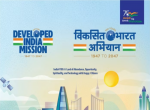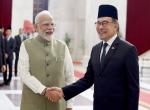India has a federal structure in which, unlike the United States of America, the Provinces were an artificial creation of the British for administrative convenience, which gained semi autonomous status under the Government of India Act, 1935. The Provinces became part of India or of Pakistan as per the Radcliff Commission’s recommendations and in India in 1950 after adoption of the Constitution they were renamed as States. The thirteen original American Colonies voluntarily came together at the time of War of Independence, constituted themselves into a Union and surrendered some of their powers to the federation. In a way they first became sovereign individually after breaking away from Britain and then voluntarily became part of the larger sovereignty of the United States. In the Declaration of Independence the General Congress of the United States stated, “We, therefore, the Representatives of the United States of America, in General Congress, Assembled, appealing to the Supreme Judge of the world for rectitude of our intentions, do, in the Name, and by Authority of the good People of these Colonies, solemnly publish and declare, That these United Colonies are, and of Right ought to be Free and Independent States …” . In other words, before declaring independence the colonies first created the federation. This is in contrast with India where the British gave us a readymade nation and, therefore, the people gave the Constitution in which first the Provinces became States and then the Constitution defined the extent of sovereignty of the Union and the States through the Seventh Schedule framed under Article 246. The difference between the two countries is further highlighted in the fact that under Article 248 residuary powers vest in Parliament in India and in the United States, under Article 10 added to the Constitution, by amendment of the Constitution residuary powers in the United States vest in the States.
This background is prepared in the context of the relationship between the Central Government and the State Governments in the matter of foreign affairs, foreign jurisdiction and treaties and agreements with foreign countries. List 1 of the Seventh Schedule of the Constitution gives the subjects which lie within the exclusive jurisdiction of Parliament and the Central Government. Entry 10 makes foreign affairs entirely the responsibility of the Central Government, just as Entries 10, 11, 12 and 13 place related issues in the domain of the Central Government. Entry 14 specifically gives exclusive powers to the Central Government to enter into treaties and agreements with foreign countries and to implement them. Constitutionally the States have no role whatsoever to play in this behalf. Even in the most loose federations foreign affairs, defence and currency and, perhaps communications are always within the exclusive jurisdiction of the federal government. No doubt the Central Government would keep the State Governments in the loop when taking decisions about foreign relations but this is not mandatory under the Constitution.
Foreign relations are always based on the mutual interests of the countries concerned and in every negotiation or treaty the objective is to arrive at a mutually acceptable decision in which, while the relations between the parties are strengthened, there is give and take between the two countries in which to gain a little we give a little. Our present Prime Minister is best placed to appreciate this because, in the nuclear agreement with the United States of America, President George W. Bush (Jr.) moved away from the established policy of the United States regarding the Comprehensive Test Ban Treaty and the Nonproliferation Treaty in order to accommodate India and Dr. Manmohan Singh moved away from a rigid stand about India never agreeing to any outside control over its nuclear establishment. This treaty has been severely criticised both in India and the United States, but both the high treating parties took a stand which, in their opinion, was the best for their respective countries. This is one case where, in the teeth of opposition and, perhaps, even perceived commonsense, Dr. Manmohan Singh took an independent and determined stand to push the treaty through.
Going back to the immediate post independence era, Jawaharlal Nehru piloted the Indo-Pakistan Treaty on division of Indus waters. He did not consult the Government of the Punjab, despite the fact that the treaty gave the major share of the water of the Indus basin to Pakistan. The then government thought that this is in the best interest of both countries. Of course this hope was belied because of the intransigence of Pakistan and our incompetence in exploiting fully our share of Indus water. After the 1965 war, at Tashkent Lal Bahadur Shastri and Field Marshal Ayub signed the Tashkent Pact. India returned to Pakistan all the territories in Pakistan Punjab, Sindh and Jammu & Kashmir captured by the Indians, despite the fact that in Jammu & Kashmir India was returning land which legitimately is a part of the State in Jammu & Kashmir, which had acceded to India and whose whole territory is Indian by right. Shastriji did not consult the Government of Jammu & Kashmir in the behalf because in signing a treaty with a foreign power it is his government which had exclusive jurisdiction and he did what he thought was right for India. In signing the treaty on Farakka Indira Gandhi went ahead despite the strong reservation expressed by Government of West Bengal. For her the treaty was important in order to keep Bangladesh on our side.
In sharp contrast is the current situation, after Sheikh Mujeeb-ur Rahman’s assassination the government and people of Bangladesh drifted towards military government, founded on religious fundamentalism and with a strong anti Indian bias. Instead of having a friendly independent country on our eastern borders, the division of Pakistan into Bangladesh and residual Pakistan created for India on its northern and western border the Islamic Republic of Pakistan thirsting for revenge over the Bangladesh humiliation and on our eastern border an independent country slipping into Islamic militant fundamentalism which gave shelter to anti Indian forces from Assam, Nagaland and other areas where there was insurgency.
Sheikh Hasina’s accession to power restored democracy to Bangladesh. Islamic fundamentalism began to recede under the pressure of democratic politics. The anti Indian stance not only softened but moved towards a positive attitude towards India. This is the stage at which it became necessary for India to take steps which would strengthen our mutual relationship and create an environment of cooperation and friendship between the two countries. The Prime Minister decided to visit Bangladesh and on the basis of prolonged consultation with that country he decided that the following items should form part of a treaty between them: - (1) An agreement on mutual exchange of enclaves isolated within both the countries (2) An agreement which would allow us to use Chittagong and other Bangladesh ports for transport of goods and other materials meant for Assam, North Bengal and other North Eastern States. (3) Free transit through Bangladesh of these goods from Chittagong to their Indian destinations. (4) A firm agreement in sharing of the waters of the Teesta River and its tributaries so that Bangladesh was guaranteed water as a lower riparian.
Because the Teesta largely services North Bengal the Chief Minister of West Bengal, Mamata Banerji, was consulted and was invited to be a part of the Indian delegation. At the last minute the lady not only refused to go to Dhaka with the Prime Minister but she also strongly objected to the Teesta water sharing formula. According to her this would deprive North Bengal of a fair share of water. Nothing would make her budge, not even the greater national interest.
What would a strong government have done? It would have certainly tried to keep the Government of West Bengal on board, but it would not have allowed the State Government to not only dictate terms on a foreign treaty but to actually scuttle it. It did not firmly tell the Chief Minister of West Bengal, as it should have, that the Government of India would protect the rights of the upper riparian, but it could not ignore the rights of the lower riparian, Bangladesh, in the matter of division of Teesta waters. The proposal of the Government of India gave marginally more water to Bangladesh than was acceptable to the Chief Minister of West Bengal, but if that won us the friendship of our neighbour, national interest demanded that we take this course of action. As in all other matters, except the nuclear deal, the Government of India surrendered to the demand of Mamata Banerji and the Prime Minister of India went to Dhaka with an empty bag. All he got was platitudes and an agreement on about one-third of the enclaves. No agreement was signed on Teesta and, in return, Bangladesh did not sign an agreement on the use of Chittagong Port and transit of goods to Assam and North Bengal through Bangladesh. Going with an empty bag Dr. Manmohan Singh also returned with an empty bag. The only beneficiaries of this visit are the critics of Sheikh Hasina who will undoubtedly try once again to steer Bangladesh towards an anti Indian slant.
This paper bears the title “A Government in Tatters”. Is the continued support of Trinamul Congress so important to government that it is prepared to throw in the trash can a treaty which would have given us a true friend on our eastern border? Is the support of a State Government more important than friendly relations with a neighbour that was being transformed into a potential enemy by local compulsions? Is reneging on what was virtually a promise to another country conducive to enhancing India’s prestige in the world? It is these questions which suggest that government is in tatters and we are undergoing a major crisis of government.
-------------------------------------------------
Published Date: 22nd September, 2011









Post new comment